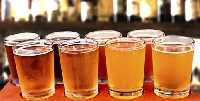What is an IPA beer vs lager?
By Catalogs Editorial Staff

Ready to order? Know the difference between IPA beer and a lager
A few years ago, people spoke of craft beer as though it was something of a fad, but over the years these new styles of ale and lager seem to have found their place in American culture.
Nearly every major supermarket and liquor store chain in America has a section devoted specifically to craft beer. One of, or perhaps the most popular style of craft beer today is the IPA or India Pale Ale. So what exactly is an “IPA” and how is it different from a lager? Let’s delve into the origins of this popular brew and discuss how it is made.
Despite its name, this brew actually has origins in early 18th century England. At the time pale ales were popular with both working and upper class English folk due to their light body, refreshing flavor, and easy drinkability.
When the British began to colonize India, they needed a way to ship pale ale over a long journey without the beer becoming dank or skunky. In order to achieve this, the brewers began adding extra hops during the brewing process to keep the flavor bold and bitter. Some brewers would also add the hops after brewing by sprinkling them directly into the barrel to be exported, a process that came to be known as dry hopping. All the extra hops are what give the IPA its distinctive bitterness, which is not as present in other pale ales.
~
In time, this ?export lager? (as it was known then) became popular with dock workers, colonists, military men and those affiliated with the East India Trading Company. By the mid eighteen hundreds, India Pale Ale had a serious following all over England and in other parts of western Europe.
Today India Pale Ales are brewed all over the world, with many different variations on the original recipe of a standard pale ale with extra hops. Some are infused with other flavors such as citrus or fruit, which adds a bit of sweetness to balance out the bitterness of the hops. There is also a variation known as the India pale lager which infuses the hoppy flavor of the IPA with a rich, malty lager style beer.
IPAs also now come in different strengths of bitterness, usually labeled as double, triple, or quadruple IPAs, depending on the measure of hop used in the brewing process. There are also 30, 60, and 120-minute IPAs, which measure the intensity of the bitterness by the length of time that the beer spends in the dry hopping process.
In American beer culture, IPAs are largely divided into two groups: East and West-coast IPAs, with the main difference being the extra malt presence in the west coast IPAs.
Now that we have covered the basics of the IPA it is time to go out and give this brew a try. It is best paired with lighter dishes that also have lots of spice, think fish tacos or spicy ceviche.
It should be noted that while the IPA is a lighter ale it is not what you would call a ?lawn mower? beer, it doesn?t really retain the refreshing qualities of a standard pale ale, so it’s probably not the best thing to serve at, say, a summer garden party.
Popular Savings Offers











